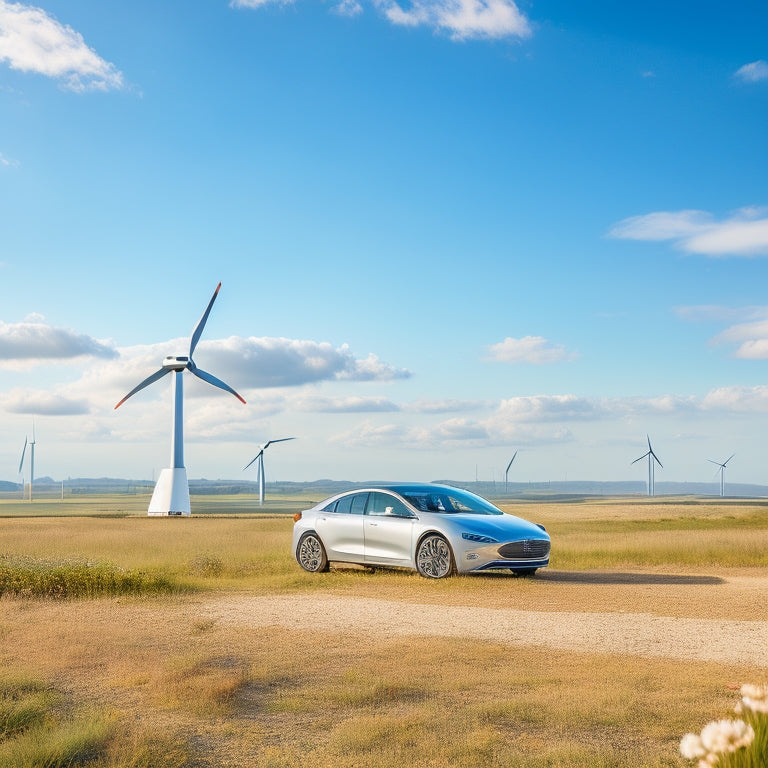
Ford's Electric Vehicles: Green and Efficient Options
Share
Ford offers a diverse range of electric vehicles, including fully electric cars, plug-in hybrids, and traditional hybrids, catering to distinct driving needs and preferences. Fully electric cars provide a median range of 250 miles on a single charge, while plug-in hybrids combine electric and gas power for short trips. Traditional hybrids recharge while driving, suitable for daily use. By choosing Ford's electric vehicles, owners can reduce their ecological footprint, benefiting from federal tax credits, lower operating costs, and reduced emissions. As you explore Ford's electric options, discover how to maximize their benefits and optimize your driving experience.
Key Takeaways
• Ford offers a range of electric vehicles, including fully electric cars, plug-in hybrids, and traditional hybrids, catering to distinct driving needs and preferences.
• Fully electric Ford cars have a median range of 250 miles on a single charge, making them suitable for daily use and long trips.
• Electric vehicle owners can reduce their ecological footprint and enjoy lower operating costs, plus a federal tax credit of up to $7,500.
• Electric vehicles require less maintenance due to fewer moving parts, resulting in a smoother, quieter ride and instant torque.
• Understanding charging and battery care is crucial, and regular maintenance checks can help identify potential issues early on.
Understanding Ford's EV Options
Ford offers a diverse range of electric vehicles, comprising fully electric cars, plug-in hybrids, and traditional hybrids, each catering to distinct driving needs and preferences.
Ford's EV lineup provides eco-friendly transportation options for environmentally conscious consumers. Fully electric cars offer a median range of 250 miles on a single charge, with the smallest environmental footprint and biggest savings on maintenance and fuel.
Plug-in hybrids combine electric and gas power, ideal for short trips, while traditional hybrids recharge while driving, suitable for daily use.
Ford's EV options cater to various lifestyles, providing a range of choices for those seeking eco-friendly transportation solutions.
Benefits of Going Electric
In addition to reducing their ecological footprint, electric vehicle owners can reap significant financial benefits, including a federal tax credit of up to $7,500 and additional savings from local incentives.
By choosing an electric vehicle, owners can enjoy lower operating costs, with reduced emissions and lower costs per mile compared to traditional gas-powered vehicles. Electric vehicles require less maintenance, with fewer moving parts and no oil changes needed, resulting in lower maintenance costs over time.
Additionally, electric vehicles provide a smoother, quieter ride and instant torque, making for a more enjoyable driving experience. With the benefits of going electric, Ford's electric vehicles offer a compelling option for those seeking a more environmentally friendly and cost-effective mode of transportation.
Owning and Maintaining an EV
When it comes to owning and maintaining an electric vehicle, understanding the charging process and battery care is important for peak performance and longevity.
To guarantee top performance, it's vital to follow proper charging tips and battery care guidelines.
- Charge your EV regularly to maintain battery health
- Avoid extreme temperatures when charging
- Monitor your battery's state of charge to prevent overcharging
- Rotate your tires regularly to maintain even wear
- Schedule regular maintenance checks to identify potential issues early on
Frequently Asked Questions
Can I Charge My EV at a Standard Household Outlet?
"As the electric vehicle revolution shifts into high gear, a pressing question emerges: can you charge your EV at a standard household outlet? Yes, but prioritize outlet safety and be aware that Level 1 charging speeds are slower, taking up to 24 hours for a full charge."
How Do I Find Public Charging Stations Near My Location?
To find public charging stations near your location, utilize online platforms like PlugShare or ChargeHub, which provide interactive maps and filters to identify nearby Charging Networks with real-time Station Availability, ensuring seamless EV charging experiences.
Are Electric Vehicles More Prone to Battery Degradation?
Electric vehicles' battery degradation is influenced by factors such as charging patterns, temperature, and battery health. Proper charging habits, avoiding extreme temperatures, and maintaining good battery health can minimize degradation, ensuring peak performance and lifespan.
Can I Install a Level 2 Charger in My Home Myself?
Before installing a Level 2 charger at home, carry out a thorough Home Inspection to guarantee a safe and compatible electrical infrastructure, following Charger Safety standards and guidelines to avoid potential electrical hazards.
Do Electric Vehicles Have Fewer Moving Parts Than Traditional Cars?
Electric vehicles (EVs) indeed have fewer moving parts than traditional cars, boasting a simplified design that enhances mechanical reliability, with fewer components prone to wear and tear, resulting in reduced maintenance needs and increased overall efficiency.
Related Posts
-

Why Solar HVAC Filters Revolutionize Home Energy Efficiency
By adopting solar HVAC filters, you're shifting your home's energy reliance from fossil fuels to clean, renewable sou...
-

What Tax Deductions Apply to Sustainable Building Materials?
You can claim various tax deductions for sustainable building materials, thanks to over 40 federal tax incentives sup...
-

Why Grow Up? Vertical Gardens Transform Urban Living
As you change your urban living space, you're not just growing up - you're bringing nature back into the heart of the...


